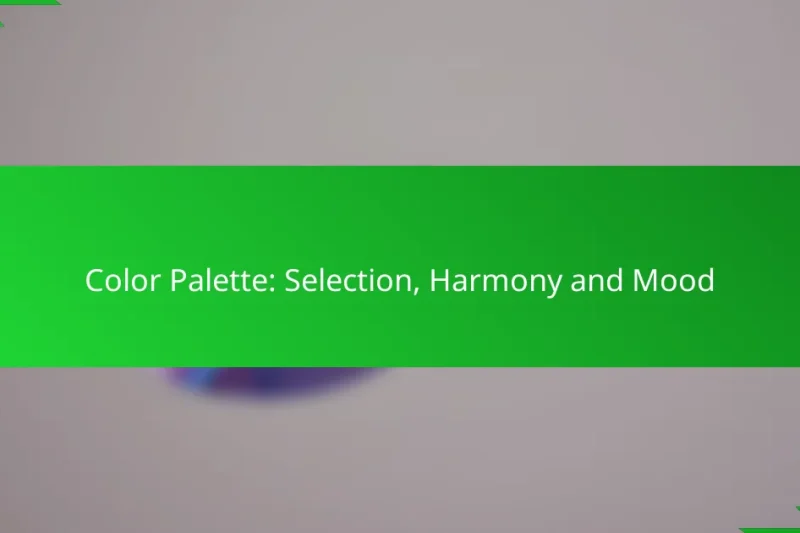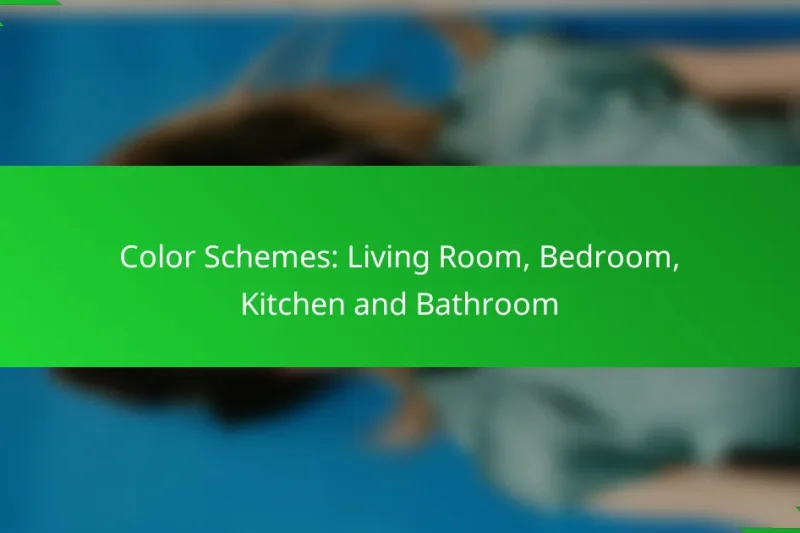Color plays a crucial role in home decor, but common mistakes can easily disrupt the desired … Color Mistakes: Common Errors, Solutions and TipsRead more
Home Decor Color Schemes
Choosing the right color scheme for your home decor can transform your space and enhance its overall ambiance. Whether you’re working with a small area or a larger room, understanding the interplay of colors is essential to create a harmonious environment. In 2023, trends lean towards earthy tones, bold jewel hues, and soft pastels, each offering distinct atmospheres that cater to various styles and preferences.
Color Palette: Selection, Harmony and Mood
Choosing the right color palette is essential for conveying your brand identity and connecting with your … Color Palette: Selection, Harmony and MoodRead more
Neutrals vs Bold Colors: Impact, Balance and Style
Neutrals and bold colors play a crucial role in shaping the atmosphere and functionality of interior … Neutrals vs Bold Colors: Impact, Balance and StyleRead more
Color Schemes: Living Room, Bedroom, Kitchen and Bathroom
Color schemes play a crucial role in defining the ambiance of different spaces in your home, … Color Schemes: Living Room, Bedroom, Kitchen and BathroomRead more
Accent Colors: Selection, Placement and Impact
Accent colors play a vital role in home decor by enhancing the primary color scheme and … Accent Colors: Selection, Placement and ImpactRead more
Color Psychology: Influence, Perception and Choices
Color psychology plays a crucial role in shaping consumer behavior by influencing emotions and perceptions, which … Color Psychology: Influence, Perception and ChoicesRead more
What are the best home decor color schemes for small spaces?
The best home decor color schemes for small spaces typically involve light colors, monochromatic designs, and strategic use of accent colors. These approaches help create an illusion of space while adding visual interest and depth.
Light neutrals for spacious feel
Light neutral colors, such as whites, beiges, and soft grays, can significantly enhance the perception of space in small rooms. These shades reflect natural light, making the area feel airy and open. Consider using a combination of these tones on walls, ceilings, and larger furniture pieces to maximize the effect.
When selecting light neutrals, aim for a cohesive palette that maintains a sense of harmony. For instance, pairing a warm beige with a cooler gray can create a subtle contrast without overwhelming the space.
Monochromatic palettes for simplicity
Monochromatic color schemes involve using varying shades of a single color, which can simplify the decor and create a unified look. This approach is particularly effective in small spaces, as it avoids visual clutter and helps maintain a sense of flow. For example, a range of blues from light sky to deep navy can evoke tranquility while keeping the space feeling connected.
To implement a monochromatic scheme, incorporate different textures and materials within the same color family. This adds depth and interest without straying from the simplicity of the palette.
Accent colors to add depth
Accent colors can be used strategically to add depth and personality to small spaces. By introducing bold hues through accessories like cushions, artwork, or decorative items, you can create focal points that draw the eye and enhance the overall design. For instance, a vibrant teal or a rich mustard can pop against a neutral backdrop.
When choosing accent colors, consider the overall mood you want to achieve. Warm tones can create a cozy atmosphere, while cool tones may evoke calmness. Limit the number of accent colors to two or three to avoid overwhelming the space.
How to choose a color scheme for your living room?
Choosing a color scheme for your living room involves considering the mood you want to create and how colors interact with each other. Start by identifying a primary color that resonates with your style, then build around it with complementary shades.
Consider natural light sources
Natural light significantly affects how colors appear in your living room. Rooms with ample sunlight may benefit from cooler tones, while darker spaces can be brightened with warmer shades. Observe how your space looks at different times of the day to make informed choices.
For example, if your living room faces north, consider using warmer colors like soft yellows or peach to counteract the cooler light. Conversely, south-facing rooms can handle bolder colors, as they receive more sunlight throughout the day.
Match colors with furniture styles
Your furniture style should influence your color scheme to create a cohesive look. For modern furniture, consider sleek, neutral colors like grays or whites, while traditional pieces may pair well with rich, warm hues like burgundy or deep green.
Additionally, think about the materials of your furniture. A leather sofa might look striking against a muted palette, while a fabric couch could be complemented by brighter, more vibrant colors to enhance texture and warmth.
Use color wheels for harmony
Color wheels are valuable tools for selecting harmonious color schemes. They can help you identify complementary, analogous, or triadic color combinations that work well together. For instance, pairing a blue with a soft orange can create a balanced and inviting atmosphere.
When using a color wheel, aim for a mix of 60-30-10 rule: 60% of your space in a dominant color, 30% in a secondary color, and 10% in an accent color. This approach ensures visual interest without overwhelming the room.
What are trending color schemes for home decor in 2023?
In 2023, trending color schemes for home decor focus on creating inviting and stylish spaces. Popular choices include earthy tones, bold jewel tones, and soft pastel shades, each offering unique atmospheres and aesthetic appeal.
Earthy tones for warmth
Earthy tones such as terracotta, olive green, and warm browns are gaining popularity for their ability to create a cozy and inviting environment. These colors evoke a sense of nature and tranquility, making them ideal for living rooms and bedrooms.
When incorporating earthy tones, consider using them as base colors for walls or larger furniture pieces. Accents in complementary shades can enhance the overall warmth and depth of the space. Pairing these tones with natural materials like wood and stone can further emphasize the organic feel.
Bold jewel tones for luxury
Bold jewel tones like emerald green, sapphire blue, and deep ruby red add a touch of luxury and sophistication to home decor. These rich colors can create a dramatic focal point in any room, making them perfect for accent walls or statement furniture.
To effectively use jewel tones, balance them with neutral colors to prevent overwhelming the space. Consider using metallic accents, such as gold or brass, to enhance the opulence of these hues. A well-placed jewel-toned accessory can elevate the overall design without dominating the room.
Pastel shades for calmness
Pastel shades, including soft pinks, light blues, and gentle greens, are ideal for creating a serene and calming atmosphere. These colors work well in spaces designed for relaxation, such as bedrooms and home offices.
When using pastel shades, aim for a monochromatic palette or combine them with white or light gray for a fresh look. Incorporating soft textures, like plush rugs or lightweight curtains, can enhance the calming effect of these colors. Avoid overly bright accents that may disrupt the tranquility of the space.
How do color schemes affect mood in home decor?
Color schemes significantly influence mood and atmosphere in home decor. Different colors evoke various emotional responses, making it essential to choose hues that align with the desired ambiance of a space.
Warm colors promote energy
Warm colors, such as reds, oranges, and yellows, are known to stimulate energy and enthusiasm. These hues can create a vibrant atmosphere, making them ideal for social spaces like living rooms and dining areas.
When using warm colors, consider balancing them with neutral tones to avoid overwhelming the senses. For example, a bright orange accent wall can be complemented with beige furniture for a lively yet comfortable environment.
Cool colors enhance relaxation
Cool colors, including blues, greens, and purples, are associated with calmness and tranquility. These shades are perfect for areas intended for relaxation, such as bedrooms and bathrooms.
To create a soothing atmosphere, opt for soft, muted versions of cool colors. Light blue walls paired with white linens can evoke a serene retreat, promoting restful sleep and relaxation.
Neutral colors provide balance
Neutral colors like whites, grays, and beiges serve as a grounding element in home decor. They provide balance and can harmonize contrasting colors, making them versatile for any room.
Using neutral colors as a base allows for flexibility in adding accent colors without overwhelming the space. For instance, a gray living room can be enhanced with colorful cushions or artwork, maintaining a cohesive yet dynamic look.
What are the top color combinations for modern kitchens?
Top color combinations for modern kitchens include white and navy, gray and yellow, and black and gold. These pairings not only enhance aesthetics but also create distinct atmospheres that can influence the overall feel of the space.
White and navy for elegance
The combination of white and navy creates a timeless and elegant look in modern kitchens. White cabinetry paired with navy accents, such as a backsplash or island, offers a clean and sophisticated contrast.
To achieve this look, consider using white for larger surfaces and navy for smaller details. This balance allows the navy to stand out without overwhelming the space. Accessories like navy dishware or bar stools can further enhance the theme.
Gray and yellow for brightness
Gray and yellow is a vibrant combination that brings brightness and energy to modern kitchens. The neutrality of gray serves as a perfect backdrop for the cheerful pops of yellow, creating a lively atmosphere.
Incorporate gray through cabinetry or countertops, while using yellow for accents such as wall art, kitchen towels, or decorative vases. This pairing works well in both small and large kitchens, as it can easily be adjusted to fit the space.
Black and gold for sophistication
The black and gold combination exudes sophistication and luxury in modern kitchens. Black cabinetry or appliances paired with gold fixtures or hardware creates a striking contrast that feels upscale.
To implement this scheme, focus on matte black finishes for a contemporary look, while using shiny gold for faucets, light fixtures, or cabinet handles. This combination is particularly effective in larger kitchens where the bold colors can be balanced with lighter elements like white or gray walls.





